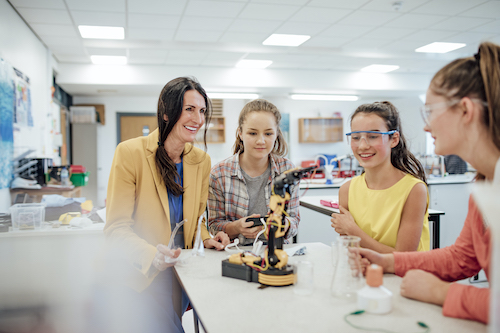Key points:
- AI can optimize the learning experience, the classroom is a delicate ecosystem and changes can have unintended effects
- AI is the future of work, and students must be prepared for it–and be familiar with it
- See related article: It’s important to teach generative AI–here’s why
- Everything You Need To Know About AI In Education
Sometime late last year, AI reached an inflection point. Experts have been making grand predictions on its behalf for decades, but the moment OpenAI opened ChatGPT up to the public, the actual potential of this technology became clear on a mass level. Almost instantly, hundreds of articles began to appear on the transformative potential of AI for fields as diverse as medicine, law, and entertainment.
Of course, some fields are more amenable to technological revolutions than others. You can see why lawyers, for instance, might appreciate instantly generated summaries of past case law—but the implications of AI in the classroom might be trickier. Teachers are understandably wary; they’re interested in anything that might optimize the learning experience, but they also know that the classroom is a delicate ecosystem, and that any change can have unintended knock-on effects.
These concerns are understandable. Change is scary. In the particular case of AI, the potential positives are too significant to ignore. Let’s discuss the opportunities and challenges AI can bring to education.
Teachers are experiencing burnout at higher rates than ever
The consequences of the pandemic continue to be felt by teachers and students in classrooms. As countless experts have pointed out, the change the pandemic inflicted on children has led to deteriorating behavioral skills and social anxiety. Teachers were already experiencing burnout in great numbers before the pandemic, but those numbers increased even further in its aftermath, as teachers have found it challenging to help students who increasingly struggle in the classroom to stay engaged in their learning.
This is one of the arenas in which AI stands to offer the biggest benefit. Again: the classroom is a delicate ecosystem. Every action taken by the teacher has the potential to either keep things running smoothly or send attention scattering. When, for instance, a teacher turns their back to the classroom to pull up a slideshow or configure this or that application, they risk disrupting the flow of teaching and inviting distraction amongst the students. With tools like voice-activated AI assistants, teachers can keep their attention on their students at all times, pulling up needed apps or documents using a simple spoken command.
AI is the future of work—and students need to be prepared
The nature of our economy is such that by the time today’s grade-schoolers reach working age, the jobs will be very different from those available to their parents (or even their older siblings). This has been a feature of U.S. life for centuries, but in recent decades the process has sped up, and AI stands to speed it up further. In the months since ChatGPT made its grand splash, whole new career categories have emerged—you can now make a living fashioning prompts for ChatGPT or editing ChatGPT-produced text. Looking beyond writing-based jobs, we see that AI stands to alter the fundamental nature of work, eliminating some portion of jobs devoted to rote procedural tasks and rewarding the ability to think creatively.
Inevitably, U.S. pedagogy will evolve to reflect these changes in the coming years. But for children who are in school now, those changes might come too late. For that reason, familiarizing students with AI tools today—and making AI literacy a priority in the classroom—will serve students better for tomorrow.
We have a long way to go when it comes to increasing equity in the classroom—and AI can help
In addition to affecting classroom behavioral issues, the pandemic also widened existing inequities across racial and socioeconomic lines for students. A study in PLOS of almost 300,000 students demonstrated “large inequalities in the learning loss based on parental education and parental income, on top of already existing inequalities.” This isn’t, of course, the fault of teachers, who are themselves stretched to their limit and working as hard as they can—but it is something that needs to be reckoned with.
AI has a significant role to play here, too. Teachers today are faced with a daily avalanche of rote administrative tasks, which in aggregate, prevent them from giving some students the kind of extra attention they need. AI—by simplifying and automating these repetitive tasks and granting teachers more time to focus on their students—can grant teachers the time and focus required to meet the unique needs of every single student.
Perhaps the most astonishing thing about an app like ChatGPT is that everyone who uses it knows it’s just the tip of the iceberg. We have all seen how technology has evolved over the last few decades—we know that things get exponentially better. AI is already serving the needs of teachers in some classrooms across the country, and its capabilities are likely to multiply as the years go on. Can it solve every problem in the classroom? Of course not—nor should it. The central figure in the classroom is and always will be the teacher.
Related:
6 ways AI tools will impact tutoring
Can GPT-4 and TikTok usher in a new learning frontier?
- 4 ways to encourage play in education - April 25, 2024
- CoSN IT Leader Spotlight: Lisa Higgins - April 25, 2024
- It’s time to pay student teachers - April 25, 2024

